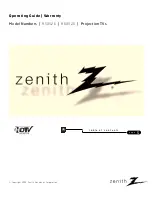
6 F 2 T 0 1 7 2
Label
Color
Remarks
IN SERVICE
Green
Lit when the relay is in service and flashing when the relay is in “Test”
menu.
TRIP
Red
Lit when a trip command is issued.
ALARM
Yellow
Lit when an alarm command is issued or a relay alarm is detected.
Relay Fail
Red
Lit when a relay failure is detected.
CB CLOSED
R /G / Y
Lit when CB is closed.
CB OPEN
Green
Lit when CB is open.
Local
Yellow
Lit when Local Control is enabled
Remote
Yellow
Lit when Remote Control is enabled
(LED1)
R / G / Y
user-configurable
(LED2)
R / G / Y
user-configurable
(LED3)
R / G / Y
user-configurable
(LED4)
R / G / Y
user-configurable
(LED5)
R / G / Y
user-configurable
(LED6)
R / G / Y
user-configurable
LED1-6 are configurable. For the setting, see Section 4.2.6.10.
The TRIP LED lights up once the relay is operating and remains lit even after the trip command
goes off. The TRIP LED can be turned off by pressing the RESET key. Other LEDs are lit as
long as a signal is present and the RESET key is invalid while the signal is being maintained.
Operation keys
The operation keys are used to display records, status, and set values on the LCD, as well as to
input or change set values. The function of each operation key is as follows:
▼
,
▲
,
▲
,
▼
: Used to move between lines displayed on a screen and to enter numerical
values and text strings.
CANCEL :
Used to cancel entries and return to the upper screen.
END :
Used to end the entering operation, return to the upper screen or turn off the
display.
ENTER :
Used to store or establish entries.
RESET key
Pressing RESET key causes the Trip LED to turn off and latched output relays to be released.
Control key
The control keys are used for CB control. When the cursor of the LCD display is not at the CB
control position-(CB close/open , Local / Remote), the Control key do not function.
①
○
: Used for CB open operation. When CB is in the open position, the
○
key does
not function.
80
Summary of Contents for GRE110
Page 183: ...6 F 2 T 0 1 7 2 Appendix B Signal List 184 ...
Page 191: ...6 F 2 T 0 1 7 2 Appendix C Event Record Items 192 ...
Page 196: ...6 F 2 T 0 1 7 2 Appendix D Binary Output Default Setting List 197 ...
Page 199: ...6 F 2 T 0 1 7 2 Appendix E Relay Menu Tree 200 ...
Page 210: ...6 F 2 T 0 1 7 2 Appendix F Case Outline 211 ...
Page 211: ...6 F 2 T 0 1 7 2 Case Outline for model 400 401 420 421 820 and 821 212 ...
Page 212: ...6 F 2 T 0 1 7 2 Case Outline for model 402 and 422 213 ...
Page 213: ...6 F 2 T 0 1 7 2 Appendix G Typical External Connection 214 ...
Page 245: ...6 F 2 T 0 1 7 2 Appendix J Return Repair Form 246 ...
Page 249: ...6 F 2 T 0 1 7 2 Customer Name Company Name Address Telephone No Facsimile No Signature 250 ...
Page 250: ...6 F 2 T 0 1 7 2 Appendix K Technical Data 251 ...
Page 256: ...6 F 2 T 0 1 7 2 Appendix L Symbols Used in Scheme Logic 257 ...
Page 259: ...6 F 2 T 0 1 7 2 Appendix M Modbus Interoperability 260 ...
Page 289: ...6 F 2 T 0 1 7 2 Appendix N IEC60870 5 103 Interoperability 290 ...
Page 296: ...6 F 2 T 0 1 7 2 Appendix O PLC Default setting 297 ...
Page 298: ...6 F 2 T 0 1 7 2 Appendix P Inverse Time Characteristics 299 ...
Page 304: ...6 F 2 T 0 1 7 2 Appendix Q IEC61850 Interoperability 305 ...
















































